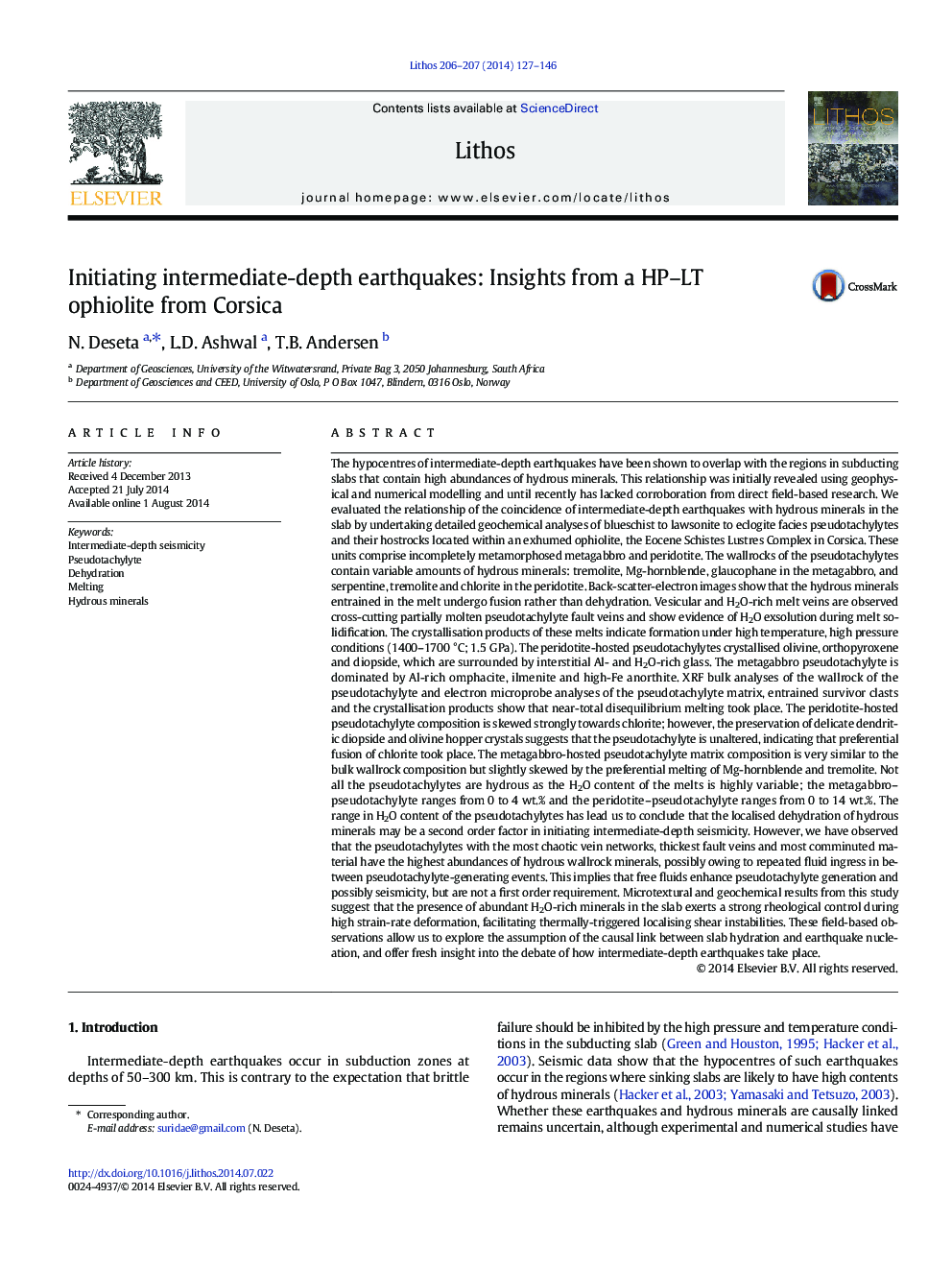| کد مقاله | کد نشریه | سال انتشار | مقاله انگلیسی | نسخه تمام متن |
|---|---|---|---|---|
| 4715943 | 1638672 | 2014 | 20 صفحه PDF | دانلود رایگان |

• We analysed the geochemistry and microtextures of blueschist facies pseudotachylytes.
• Hydrous minerals in the wallrock undergo preferential wholesale fusion.
• There is no evidence of prograde dehydration reactions.
• Al-rich omphacite in the pseudotachylyte indicates formation temperature > 1700 °C.
The hypocentres of intermediate-depth earthquakes have been shown to overlap with the regions in subducting slabs that contain high abundances of hydrous minerals. This relationship was initially revealed using geophysical and numerical modelling and until recently has lacked corroboration from direct field-based research. We evaluated the relationship of the coincidence of intermediate-depth earthquakes with hydrous minerals in the slab by undertaking detailed geochemical analyses of blueschist to lawsonite to eclogite facies pseudotachylytes and their hostrocks located within an exhumed ophiolite, the Eocene Schistes Lustres Complex in Corsica. These units comprise incompletely metamorphosed metagabbro and peridotite. The wallrocks of the pseudotachylytes contain variable amounts of hydrous minerals: tremolite, Mg-hornblende, glaucophane in the metagabbro, and serpentine, tremolite and chlorite in the peridotite. Back-scatter-electron images show that the hydrous minerals entrained in the melt undergo fusion rather than dehydration. Vesicular and H2O-rich melt veins are observed cross-cutting partially molten pseudotachylyte fault veins and show evidence of H2O exsolution during melt solidification. The crystallisation products of these melts indicate formation under high temperature, high pressure conditions (1400–1700 °C; 1.5 GPa). The peridotite-hosted pseudotachylytes crystallised olivine, orthopyroxene and diopside, which are surrounded by interstitial Al- and H2O-rich glass. The metagabbro pseudotachylyte is dominated by Al-rich omphacite, ilmenite and high-Fe anorthite. XRF bulk analyses of the wallrock of the pseudotachylyte and electron microprobe analyses of the pseudotachylyte matrix, entrained survivor clasts and the crystallisation products show that near-total disequilibrium melting took place. The peridotite-hosted pseudotachylyte composition is skewed strongly towards chlorite; however, the preservation of delicate dendritic diopside and olivine hopper crystals suggests that the pseudotachylyte is unaltered, indicating that preferential fusion of chlorite took place. The metagabbro-hosted pseudotachylyte matrix composition is very similar to the bulk wallrock composition but slightly skewed by the preferential melting of Mg-hornblende and tremolite. Not all the pseudotachylytes are hydrous as the H2O content of the melts is highly variable; the metagabbro–pseudotachylyte ranges from 0 to 4 wt.% and the peridotite–pseudotachylyte ranges from 0 to 14 wt.%. The range in H2O content of the pseudotachylytes has lead us to conclude that the localised dehydration of hydrous minerals may be a second order factor in initiating intermediate-depth seismicity. However, we have observed that the pseudotachylytes with the most chaotic vein networks, thickest fault veins and most comminuted material have the highest abundances of hydrous wallrock minerals, possibly owing to repeated fluid ingress in between pseudotachylyte-generating events. This implies that free fluids enhance pseudotachylyte generation and possibly seismicity, but are not a first order requirement. Microtextural and geochemical results from this study suggest that the presence of abundant H2O-rich minerals in the slab exerts a strong rheological control during high strain-rate deformation, facilitating thermally-triggered localising shear instabilities. These field-based observations allow us to explore the assumption of the causal link between slab hydration and earthquake nucleation, and offer fresh insight into the debate of how intermediate-depth earthquakes take place.
Journal: Lithos - Volumes 206–207, October 2014, Pages 127–146